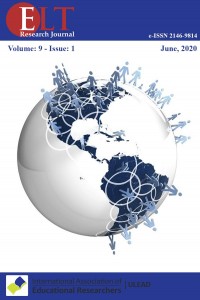Abstract
References
- Boling, E.C., Hough, M., Krinsky, H., Saleem, H. and Stevens, M. (2012). Cutting the distance in distance education: Perspectives on what promotes positive, online learning experiences. The Internet and Higher Education, 15(2), 118-126.
- Cummins, J. (2002). The potential of ICT to promote academic language learning. In proceedings of the 3rd International Conference Information and Communication Technology in Education. Rhodes: University of Aegean, 55-64.
- Curtis, S.A., Duchastel J. & Radic N. (1999). Proposal for an online language course. ReCALL 2, 38-45.
- Garrison, D.R., Anderson, T. (2003). E-learning in the 21st century: framework for research and practice, Routledge.
- Garrison, D. R. (1985). Three generations of technological innovations in distance education. Distance Education 6, 235-241. http://www.c3l.uni-oldenburg.de/cde/media/readings/garrison85.pdf.
- Holmes B., Gardner J. (2006). Elearning, concepts and practice. Sage Publications Ltd.
- Kasper, L.F. (2000). New technologies, new literacies: focus discipline research and ESL learning communities. Language Learning and Technology Journal, 4.2., 105-28. http://llt.msu.edu/vol4num2/kasper/default.html.
- Kearsley, G. (2005). Online learning: personal reflections on the transformation of education. Educational Technology publications, New Jersey.
- Keegan, D. (2000). Foundations of Distance Education. London: Routledge.
- Legenhausen, L. (1999). Traditional and autonomous learners compared: The impact of classroom culture on communicative attitudes and behaviour, In C.Edelhoff & R.Weskamp, Autonomes Fremdsprachenlernen (pp.166-82). Munich: Max Hueber.
- Petz, B., Kolesarić, V., Ivanec, D., Milas, G., Podlesek, A. and Galić, Z. (2012). Petzova statistika: osnovne statističke metode za nematematičare. Naklada Slap.
- Shetzer, H. (1998, March). Electronic literacies: Bridging the gap. Paper presented at the conference of Teachers of Speakers of Other Languages, Seattle.
- Warschauer, M. (1996). Comparing face-to-face and electronic discussion in the second laguage classroom. CALICO Journal, 13, 7-26.
- Wang Han (2008). Benefits and barriers of computer assisted language learning and teaching. US-China Foreign Language 6, No.9. 59-64.
- White, C. (2003). Language learning in distance education, Cambridge University Press.
A Comparative Study of Bosnian and Herzegovinian Adult Foreign Language Students’ Attitudes to Teaching Four Skills in Classroom and Distance Language Learning Systems
Abstract
Widespread use of information and communication technology is a cornerstone of today's society. This results in significant changes in communication, information flow, business operations, gaining knowledge and other aspects of life. Needs and requirements in the field of education are, thus, also changing. Skills for autonomous research and lifelong learning are gaining importance. Educational institutions and teachers as individuals are faced with the challenge of changing the concept of knowledge delivery which has to imply almost inevitable integration of modern technology. Considering the need to change educational systems in accordance with the changes in the society, marked by constant increase of information and knowledge base as well as by dynamic and fast paced development of information and communication technology, distance education is becoming an increasingly significant concept. A need to learn foreign languages is always present, regardless of teaching methods. This paper considers possibilities and specific elements throughout the process of teaching a foreign language in the distance education system compared to the traditional, in-class teaching system. The goal of the research is to analyze whether the methods of foreign language teaching used in the distance education system can be as equally efficient as the traditional teaching methods and whether the lack of face-to-face contact in the distance education system can be compensated by the use of information and communication technology.
References
- Boling, E.C., Hough, M., Krinsky, H., Saleem, H. and Stevens, M. (2012). Cutting the distance in distance education: Perspectives on what promotes positive, online learning experiences. The Internet and Higher Education, 15(2), 118-126.
- Cummins, J. (2002). The potential of ICT to promote academic language learning. In proceedings of the 3rd International Conference Information and Communication Technology in Education. Rhodes: University of Aegean, 55-64.
- Curtis, S.A., Duchastel J. & Radic N. (1999). Proposal for an online language course. ReCALL 2, 38-45.
- Garrison, D.R., Anderson, T. (2003). E-learning in the 21st century: framework for research and practice, Routledge.
- Garrison, D. R. (1985). Three generations of technological innovations in distance education. Distance Education 6, 235-241. http://www.c3l.uni-oldenburg.de/cde/media/readings/garrison85.pdf.
- Holmes B., Gardner J. (2006). Elearning, concepts and practice. Sage Publications Ltd.
- Kasper, L.F. (2000). New technologies, new literacies: focus discipline research and ESL learning communities. Language Learning and Technology Journal, 4.2., 105-28. http://llt.msu.edu/vol4num2/kasper/default.html.
- Kearsley, G. (2005). Online learning: personal reflections on the transformation of education. Educational Technology publications, New Jersey.
- Keegan, D. (2000). Foundations of Distance Education. London: Routledge.
- Legenhausen, L. (1999). Traditional and autonomous learners compared: The impact of classroom culture on communicative attitudes and behaviour, In C.Edelhoff & R.Weskamp, Autonomes Fremdsprachenlernen (pp.166-82). Munich: Max Hueber.
- Petz, B., Kolesarić, V., Ivanec, D., Milas, G., Podlesek, A. and Galić, Z. (2012). Petzova statistika: osnovne statističke metode za nematematičare. Naklada Slap.
- Shetzer, H. (1998, March). Electronic literacies: Bridging the gap. Paper presented at the conference of Teachers of Speakers of Other Languages, Seattle.
- Warschauer, M. (1996). Comparing face-to-face and electronic discussion in the second laguage classroom. CALICO Journal, 13, 7-26.
- Wang Han (2008). Benefits and barriers of computer assisted language learning and teaching. US-China Foreign Language 6, No.9. 59-64.
- White, C. (2003). Language learning in distance education, Cambridge University Press.
Details
| Primary Language | English |
|---|---|
| Subjects | Language Studies |
| Journal Section | Research Article |
| Authors | |
| Publication Date | August 6, 2020 |
| Submission Date | February 3, 2020 |
| Published in Issue | Year 2020 Volume: 9 Issue: 1 |


